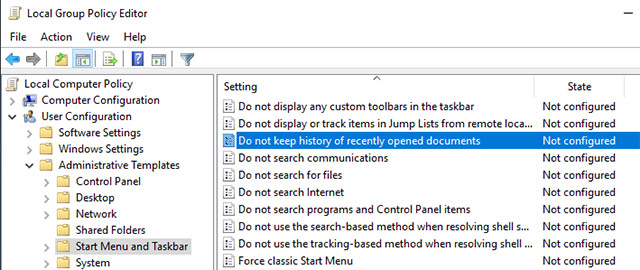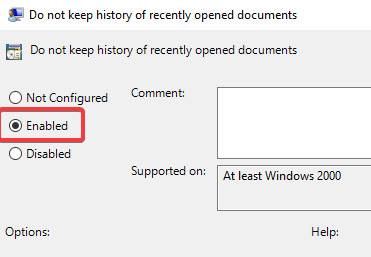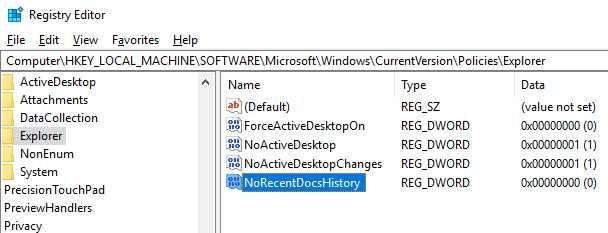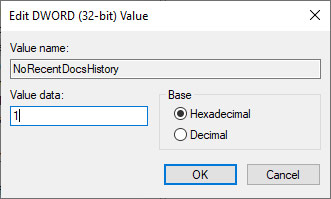How to turn off displaying recently visited items and locations in Windows 10
If you've ever right-clicked the application icon on the taskbar or in the Start menu, you might find that Windows will display a list of recent items that you have accessed on that application.In fact, Windows will also display recently opened files and locations that are frequently accessed in the File Explorer File menu.To be fair, this feature is quite useful for us in some cases, for example when you want quick access to a familiar item, for example.However, if you don't need to use this feature or simply don't want to display frequently accessed items and locations for security or privacy reasons, you can easily turn it off too. go.
Turn off displaying recently accessed items with Settings App
If you just want to turn off the display of frequently visited items and locations for your user account, use Settings App , very quickly and easily without using the registry or changing the system policy system.
1. To open the Settings App , click the Notifications icon that appears in the bottom right corner, then click the All Settings button.
2. Under Settings App , scroll to Personalization and then Start (appear on the left bar). On the right panel, switch the switch button to turn off the Show recently opened items option in Jump Lists on Start or the taskbar.

3. As soon as you switch the switch to the off position, recently accessed items and locations will be turned off immediately.If you want to re-enable this feature, just switch the switch to the On position.
Turn off the display of recent access items by using Group Policy (for all user accounts on the system)
As mentioned, the Settings App only allows you to disable this feature for a single user account. To turn off the display of recently accessed items for all user accounts on the system, you must use Group Policy . More specifically, you need to modify some policies in Group Policy Editor , available for all users from Pro to Enterprise.This method is also particularly useful for system administrators.
1. First, open the Start menu, search for the keyword 'gpedit.msc' and press Enter to open the Group Policy Editor . Next, move to the User Configuration section -> Administrative Templates -> Start Menu and Taskbar.
2. On the right panel, find and double-click the option Do not keep a history of recently opened documents .This is a policy that allows you to enable or disable the display of recently visited items and places.

3. In this window, click Enabled to turn on the radio option and click the Apply button, then OK to save these changes.

4. Change the policy Group Group policy requires you to restart the system or update the system to apply the changes, so restart the system or execute the gpupdate / force command in the command prompt with administrator status.
To re-enable this feature, simply select the Disabled or Not Configured option.
Turn off displaying recent access items from the Registry
If you are using a Windows 10 Home version and want to turn off the display of recent access items for all user accounts on your system, you can use Registry Editor.
1. First, press the Win + R key combination, type the keyword regedit and press Enter to open the Windows Registry . Now, copy the link below and paste it into the search address bar and press Enter .
HKEY_LOCAL_MACHINESOFTWAREMicrosoftWindowsCurrentVersionPoliciesExplorer
2. On the right panel, you will see there is a value named NoRecentDocsHistory . If you have this value, go to the next step. If not, right-click the blank space and select New -> DWORD (32-bit) Value .Name the newly set value 'NoRecentDocsHistory'.

3. Double-click the newly created value and set the data to the value to '1'.

You have successfully disabled the feature that displays recently visited items and locations in Windows 10 with the Windows Registry .In order for the changes you make to take effect, restart the system.If you want to revert the changes, correct the data value to "0" to clear the value "NoRecentDocsHistory".
Good luck!
See more:
- Turn off Windows Defender on Windows 10
- How to turn off Windows Update on Windows 10
- How to do, customize in the article will help your Windows 10 "as fast as the wind"
- Ways to troubleshoot audio on Windows 10
You should read it
- How to delete recent items in Search on Windows 10
- How to turn off Recent Files and Quick Access on Windows 10
- 8 ways to fix 'There Are No Startup Items to Display in the Task Manager' error on Windows
- Access commonly used items in Windows 7 with Jump Lists
- How to fix Quick Access Windows 11 error not showing recent files
- Turn off password display in Windows 8 when logging in
- How to display this list of This PC Windows 10 drives
- Change text size, applications and items in Windows 10 Mobile
May be interested
- How to Reduce Space Between Items in File Explorer Windows 11
 adjusting the spacing between items in windows 11 will allow more items to fit in a single window, reducing wasted space in windows explorer and repetitive scrolling.
adjusting the spacing between items in windows 11 will allow more items to fit in a single window, reducing wasted space in windows explorer and repetitive scrolling. - Access commonly used items in Windows 7 with Jump Lists
 with the new jump list feature in windows 7, you get quick access to recently used items.
with the new jump list feature in windows 7, you get quick access to recently used items. - How to turn off automatic reopening of the tab when starting UC Browser
 this feature will help you turn off the auto-start feature of previously visited websites when reopening uc browser
this feature will help you turn off the auto-start feature of previously visited websites when reopening uc browser - Steps to enable the new Windows 10 News and Weather Widget on your computer
 recently microsoft has officially enabled the news and interests feature for windows 10. this feature was previously visible on phones, by displaying information and news on the taskbar.
recently microsoft has officially enabled the news and interests feature for windows 10. this feature was previously visible on phones, by displaying information and news on the taskbar. - How to Determine Processor Speed
 this article describes the different locations where cpu speed is reported in microsoft windows xp. in windows xp and in windows server 2003, cpu speed is reported in the following locations: === the system properties tab === to view the...
this article describes the different locations where cpu speed is reported in microsoft windows xp. in windows xp and in windows server 2003, cpu speed is reported in the following locations: === the system properties tab === to view the... - How to preview images where needed on Google Maps
 as one of the most popular online mapping applications today, google maps provides convenience for users when you can search for locations and locations much faster. and we can observe the destination on google maps by ...
as one of the most popular online mapping applications today, google maps provides convenience for users when you can search for locations and locations much faster. and we can observe the destination on google maps by ... - 3 ways to turn off the Windows 11 firewall, steps to turn off the firewall on windows 11
 windows 11 is a new operating system released by microsoft in 2021. of course, it still has a built-in windows firewall (firewall) to ensure user safety. but if you want to turn off the firewall on windows 11, how do you do it?
windows 11 is a new operating system released by microsoft in 2021. of course, it still has a built-in windows firewall (firewall) to ensure user safety. but if you want to turn off the firewall on windows 11, how do you do it? - Learn how to fix the error of continuously displaying search results on Windows 10 effectively
 today's tipsmake will guide you on how to effectively fix the error of continuously displaying search results on windows 10.
today's tipsmake will guide you on how to effectively fix the error of continuously displaying search results on windows 10. - How to Turn on Windows Defender
 today's tipsmake will show you how to turn on windows defender on your pc. if you've turned off microsoft defender (formerly windows defender) since you last started your computer, you can turn it back on from the windows security program. if you recently installed an anti-virus program and microsoft defender was turned off, you will have to uninstall that program before you can use microsoft defender again.
today's tipsmake will show you how to turn on windows defender on your pc. if you've turned off microsoft defender (formerly windows defender) since you last started your computer, you can turn it back on from the windows security program. if you recently installed an anti-virus program and microsoft defender was turned off, you will have to uninstall that program before you can use microsoft defender again. - Steps to turn off Windows 11 Update, How to stop updating Windows 11
 microsoft regularly releases updates to patch bugs for its operating system as well as its products and services. windows 11 is also not an exception to this policy, so it will be regularly updated with patches.
microsoft regularly releases updates to patch bugs for its operating system as well as its products and services. windows 11 is also not an exception to this policy, so it will be regularly updated with patches.










 How to speed up Windows 10 startup
How to speed up Windows 10 startup What is LockApp.exe on Windows 10?
What is LockApp.exe on Windows 10? How to reset Touchpad settings on Windows 10?
How to reset Touchpad settings on Windows 10? How to attach and split VHD and VHDX files in Windows 10
How to attach and split VHD and VHDX files in Windows 10 How to use Snip & Sketch on Windows 10
How to use Snip & Sketch on Windows 10 How to open and run cmd with Admin permissions on Windows
How to open and run cmd with Admin permissions on Windows